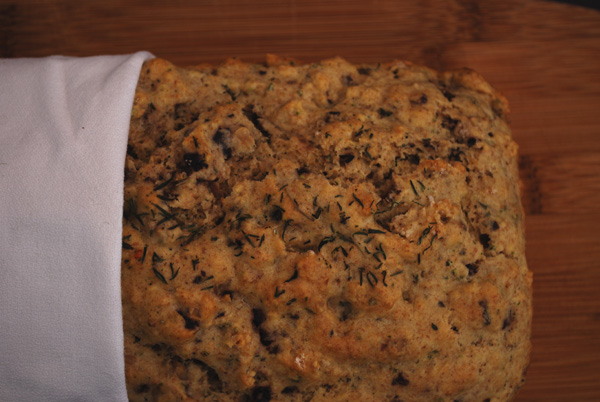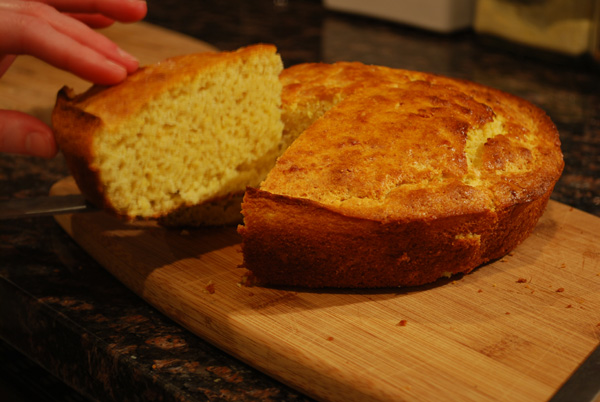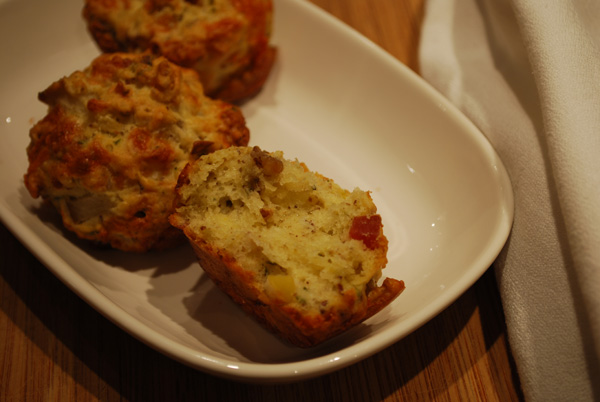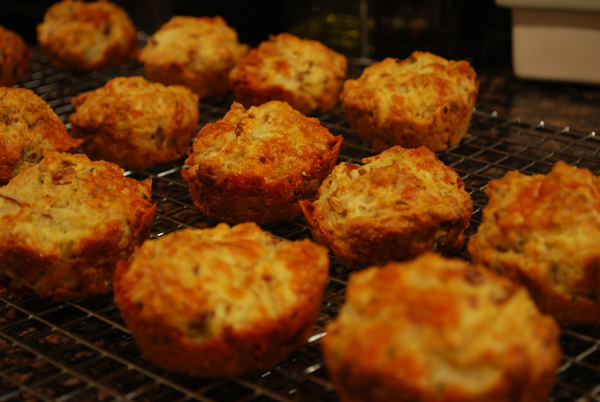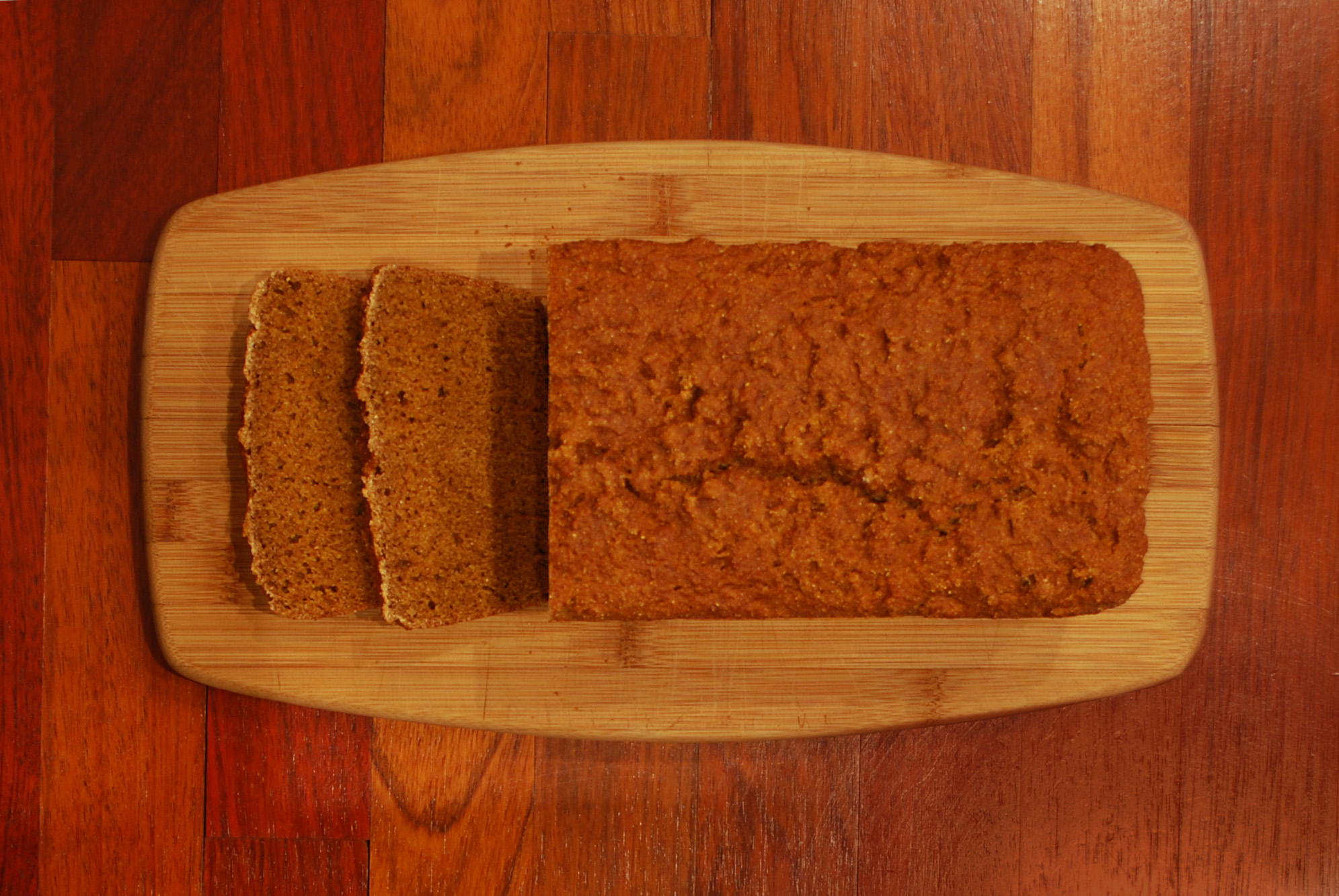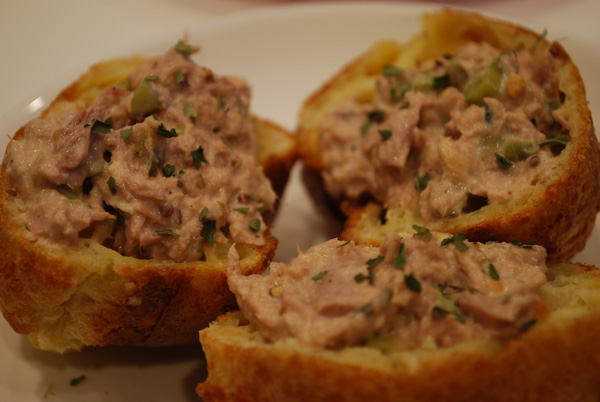Week Three: Breakfast Breads
Could there be a more Southern food than the humble biscuit? You’ll find it on tables from West Virginia to Texas, from Waffle House to the Ritz Carlton. True, it’s mainly a breakfast food, but you’ll usually find a plateful next to your fried chicken dinner. I’ve heard it said that one of the highest compliments one Southern cook can give another is that he or she “makes good biscuits”. Any houseguest South of the Mason-Dixon line can place a fairly safe bet on a breakfast of a pile of biscuits smothered with red-eye or white sausage gravy.
You know, I don’t think there’s a man, woman, or child in this country that doesn’t love a good biscuit. The only problem is everyone has their own idea of what exactly a “good” biscuit is. My personal preference (and the recipe below) is for a tall, flaky one, that you can split apart into perfect halves, and sandwich with sausage or ham. But I’m certainly not about to turn down a soft, fluffy biscuit, topped with butter and honey.
Quick to make, easy to hold, substantial, and ridiculously delicious when done right, it’s no wonder the fast food chains have taken the biscuit and run nation-wide with it. Unfortunately. You know that nasty sort of floury film you get in your mouth after you eat a fast food biscuit? That’s shortening. (Full disclosure: I think hydrogenated shortening is one of the most disgusting things ever. It looks gross and tastes like nothing. It’s not food. It’s not going to kill you immediately if you eat it, but neither will a penny. Neither one is food, though. End of rant.) Shortening has a higher melting point than your body temperature, which means that it will just sit there on your palate, grossing up your mouth. Butter, on the other hand, has a very low melting point. It melts immediately in your mouth, leaving only a sweet flavor and a pleasant memory.
What does that have to do with biscuits, you ask? Everything! What are biscuits, if not about texture? Whether you like fluffy or flaky, the type of fat you use and the way you handle the dough are both crucial elements in a good biscuit. Every biscuit recipe out there calls for cold fat. It has to be cold because if the fat warms and mixes with the flour, it forms a gooey paste and develops the gluten in the flour, making the biscuit flat and tough. Overdeveloped gluten will of course toughen the dough, but why does a gooey flour/fat paste make a biscuit flat? Biscuits rise because cold pockets of fat melt in the oven, and the space is taken over by steam and gas from the baking powder. The air expands and pushes the dough up. If the fat is mixed into the flour, there’s no little pockets for the gases to go into, so they dissipate out of the biscuit, making them dense and squat. The more evenly the fat is distributed throughout the dough, the more evenly they’ll rise.
Ok, but what about shortening vs. butter? Well, your goal is to create tiny pockets of fat, right? If you’re mixing the dough with your hands, the warmth from your hands will melt the butter, resulting in the dreaded gooey paste. But they’ll taste good. Shortening, on the other hand, will remain in little discrete units of unmelted fat for quite some time, resulting in a much better texture, but combined with a terrible flavor. (This is why mass-produced biscuits, made on rough machines, are full of shortening.) So the way to get the best of both worlds is to combine the two fats in the dough. Unfortunately.
Yes, we must use shortening. Because flaky biscuits are handled so much in the mixing, rolling, and cutting, they need that little extra help from my culinary nemesis, shortening. (Fluffy biscuits are another matter. You don’t have to roll them; in fact, it’s best not to. All butter, all the time over here.) Thankfully, the relatively small amount of shortening means little to no film on your tongue. My recommendation is to use a natural non-hydrogenated shortening, if you can. Whole Foods sells one called Jungle Shortening, made from coconut oil. It has a nice smooth texture, a lower melting point than Crisco, and is organic; so I consider it a lesser evil. My favorite way to prepare the fat is to cut it into as tiny pieces as you can, put it on a plate, and stick it in the freezer while you gather the remaining ingredients.
As for the mixing process, that’s a little trickier. If you have a big food processor, you’re in luck: you’re already halfway to making great biscuits. If not, it will probably take you a little practice to get the technique down pat. The goal is to handle the dough as little as possible, so you don’t melt the butter. Use your fingertips only, since your hand is too hot, and very quickly pinch the little bits of cold fat into slightly smaller and flatter bits. Use a big bowl for this, since things tend to fly all over if you’re doing it right. Toss the flour quickly to get the un-pinched pieces off the bottom. You want to end up with something that looks like cornmeal, or oatmeal (or any other favorite meal, I guess). If you’ve got some larger bits, it’s ok. If you’re using a food processor (lucky dog), just pulse the dry ingredients with the cold fat a few times until it looks right. Remember, practice makes perfect. I went through culinary school (for baking!), and took me a few years since to get pretty good at it; but then, I often used canned biscuits as a crutch. Don’t tell anyone.
Speaking of canned biscuits, it’s no wonder they’re so popular. Just pop the can open, and bake away! With all the nuance of the ingredients, the precautions you must take, and their short shelf life, from-scratch biscuits really are kind of a pain. Until, that is, you finally get it. You finally create, with your own hands, a biscuit that would make your grandmother proud. It’s just slightly crunchy on the outside, but soft and pillowy inside. The flavor of butter clings to your tongue, but no nasty film of shortening. And it might have taken a few tries first, but that only makes the reward that much sweeter. Well, that, and the honey that’s dripping off the melting butter onto your hand.
Flaky Biscuits
From Cook’s Illustrated’s The Best Recipe
Makes 16 biscuits
After stirring in milk, dough will be very soft and moist, but you should be able to hold it briefly between lightly floured hands without its sticking. If it turns out wet and sticky, return it to the bowl and sprinkle it with 2-4 T more flour on all sides, gently patting in the flour with your palm. Let the dough rest another half-minute before removing it to your work surface. It is best to discard the dough that is left over from the second cutting, as biscuits made with thrice-recycled dough tend to be tough and flat. If you don’t want to use a biscuit cutter, form the dough into a neat 8-inch square and cut it into squares or triangles with a knife. This eliminates all scraps and thus all the problems of re-rolling. No matter how they are cut, these biscuits are best served at once, though leftovers may be wrapped an refrigerated for a day, then reheated for a few minutes in a 350 degree oven.
2 cups high-protein all-purpose flour, such as King Arthur, or 1 cup low-protein
all-purpose flour, such as Pillsbury, and 1 cup bread flour
1 tablespoon baking powder
3/4 teaspoon salt
5 tablespoons unsalted butter, chilled and cut into 1/4 inch cubes, plus 2
tablespoons melted for brushing tops
3 tablespoons vegetable shortening or lard, chilled
3/4 cups cold milk
1. Adjust oven rack to middle position and heat oven to 450 degrees.
2. Mix flour, baking powder, and salt in a large bowl or the workbowl of a food processor fitted with steel blade. Add butter; with your fingertips, a pastry blender, 2 knives, or steel blade of a food processor, mix, cut, or process butter and shortening into dry ingredients, until the mixture resembles dry oatmeal. (Transfer food processor mixture to a large bowl.)
3. Stir in milk with a rubber spatula or fork until dry ingredients are just moistened. Let dough rest for 1 minute, then transfer it to a well-floured surface.
4. Roll dough into rough 6×10 inch rectangle. With long edge of dough facing you, fold in both short ends of dough so that they meet in center; then fold dough in half by width, forming a package of dough four layers thick. Once again, roll the dough into a 6×10 inch rectangle, about 1/2 inch thick.
5. Using a lightly greased and floured 2 inch cutter, stamp, with one decisive punch per round, 4 rows of 3 dough rounds, cutting them close together to generate as few scraps a s possible. Dip cutter into flour before each new cut. Push the scraps of dough together so that their edges join; firmly pinch the edges with fingertips to make a partial seal. Pat the dough into a small rectangle, fold it as before, and re-roll until 1/2 inch thick. Cut out 3 or 4 more biscuits.
6. Place dough rounds 1 1/2 inches apart on an ungreased baking sheet; brush dough tops with melted butter. (May be covered with plastic wrap and refrigerated up to 3 hours.)
7. Bake until biscuits are lightly browned, 10 to 12 minutes. Serve immediately.
Notes:
1. It’s important to bake these in middle of oven so they brown evenly. If they’re too close to the oven floor, the bottoms will get overdone. If they’re too close to the oven ceiling, the tops may burn.
2. The mixed flour seems like an unnecessary step, but if you can hit that protein percentage spot on, you’ll end up with the best possible biscuit. I used King Arthur, but I love their flour anyway. It’s not chemically treated like most name-brand flours, and it actually has a good flavor, not a chalky taste. Since breads are mostly made of flour, why would you want to use one that tastes a little off?
3. I didn’t brush mine with butter, and they turned out just fine. But they would’ve looked prettier and had a little more crunch on top if I had.
4. After folding and rolling out again, I cut off the ragged edge of the dough, and smushed those into two “nasty biscuits”, as my mom always called those made with scraps. The others, I cut into rectangles, since I don’t have a small round cutter. A bench scraper worked fine, as would a knife. But whatever you use, just be sure to punch decisively. And don’t twist those round cutters!
5. My dough seemed very wet for a biscuit dough, but with plenty of flour on the work surface, it was easy enough to work with. And since these biscuits turned out better than any batch I’ve made previously, I think it’s a keeper.
6. Most Southern recipes I’ve seen for biscuits generally include sugar, anywhere from 1 tablespoon to 1/4 cup. I was about to add some (out of habit?), when I held my hand out of fear of changing the texture. I guess you could add some if you like, but these were so good without it that I wouldn’t bother.
7. Sixteen biscuits? Really? I had to put my mind to it to get 14 small ones. These editors obviously aren’t Southern.

